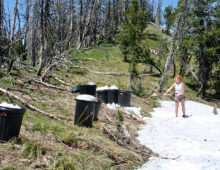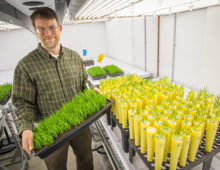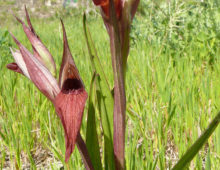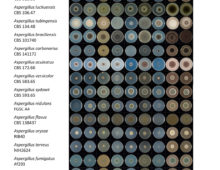How long have you collaborated with the JGI and on which projects? I’ve been working with the JGI for about ten years now. To date, all of our work has focused on some aspect of life in terrestrial geothermal springs, mostly Great Boiling Spring in northeast Nevada. These projects have included work on both microbial…
Discovered: Novel Group of Giant Viruses
Giant viruses appear to have evolved from smaller viruses (not from cells) based on presence of nearly complete set of translation-related genes. Viruses have a ubiquitous presence in the world. Their population is estimated to be 1031, 10 times greater than the nonillion (1030) of microbes on the planet—a figure that surpasses the number of…
Speciation Driven by Alleles Adapted to Local Conditions
Genome sequence analysis provides first evidence that linked, locally adapted alleles exist first, and subsequently are captured within a new, selectively-favored inversion. The Science A team of scientists investigated the pathway by which chromosomal inversions – in which a segment of the chromosome was removed, flipped and then re-inserted – contribute to speciation in nature….
Grasses: The Secrets behind Their Stomatal Success
Finding a grass gene impacting stomatal morphology underscores importance of developing mutant gene index. The Science The evolution of adjustable pores, stomata, allows plants to control the amount of CO2 that enters the plant and water that escapes by modifying the stomatal pore size. Plants have evolved two kidney shaped guard cells that swell to…
New Software Tools Streamline DNA Sequence Design-and-Build Process
Improve on existing biological computer-aided design and manufacture (bioCAD/CAM) tools The Science Synthetic DNA allows scientists to expand the breadth and depth of their genomic research. In this study researchers from the U.S. Department of Energy Joint Genome Institute (JGI) have developed a suite of build-optimization software tools (BOOST) to streamline the design-build transition in…
Nitrogen Uptake Between Fungi and Orchids
Fungal and plant gene expression provides clues to nitrogen pathways. The Science Orchids are an example of an experimentally tractable plant that is highly dependent on its relationship with its mycorrhizal fungal partners for nutrient supply. In this recent study, researchers for the first time identified some genetic determinants potentially involved in nitrogen uptake and…
Revealing Aspergillus Diversity for Industrial Applications
Comparative analysis of Aspergillus species provides genus-wide view of fungal diversity In the world of fungi, Aspergillus is an industrial superstar. Aspergillus niger, for example, has been used for decades to produce citric acid—a compound frequently added to foods and pharmaceuticals —through fermentation at an industrial scale. Other species in this genus play critical roles…
Systems Analysis of Grass Secondary Cell Wall Development
The objective of this proposal is to identify the proteins, phosphopeptides, transcripts, and metabolic signatures that mediate secondary cell wall (SCW) development in grasses. Grass cell walls are one of the most abundant potential sources of biomass for biofuel production. However, the biological conversion of grass biomass to fuel is limited by deconstruction of cell…
Global Warming Induced Salinity Shifts
The reality of global warming predicts that the survival of many organisms will be compromised due to rapid environmental changes of the ecosystems in which they live. Aquatic ecosystems are particularly vulnerable to shifts in climate. Large incursions of fresh water or water loss from lack of rainfall will cause modification in water chemistry. As…
Systems-Level Insights into Plant-Microbial-Permafrost Carbon Dynamics
A fundamental challenge of modern environmental science is to understand how earth systems will respond to climate change. A parallel challenge in biology is to understand how information encoded in organismal genes manifests as biogeochemical processes at ecosystem-to-global scales. These grand challenges intersect in the need to understand the global carbon (C) cycle, which is…






